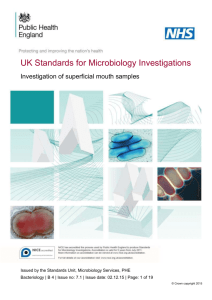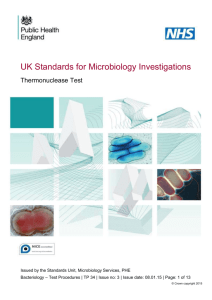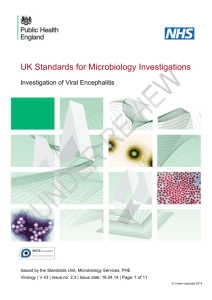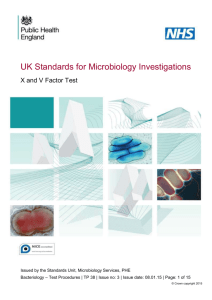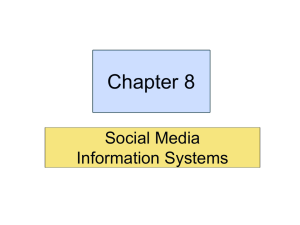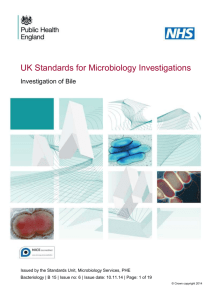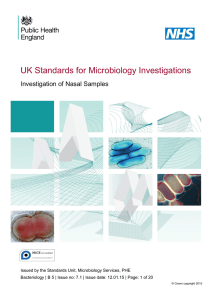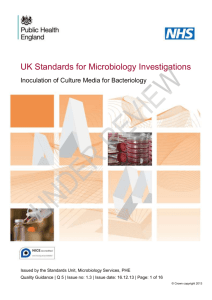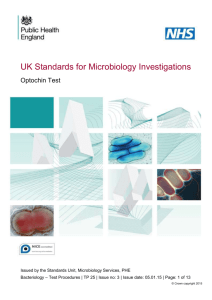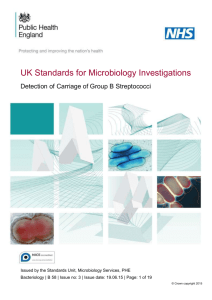B 4 - Investigation of Mouth Swabs
advertisement
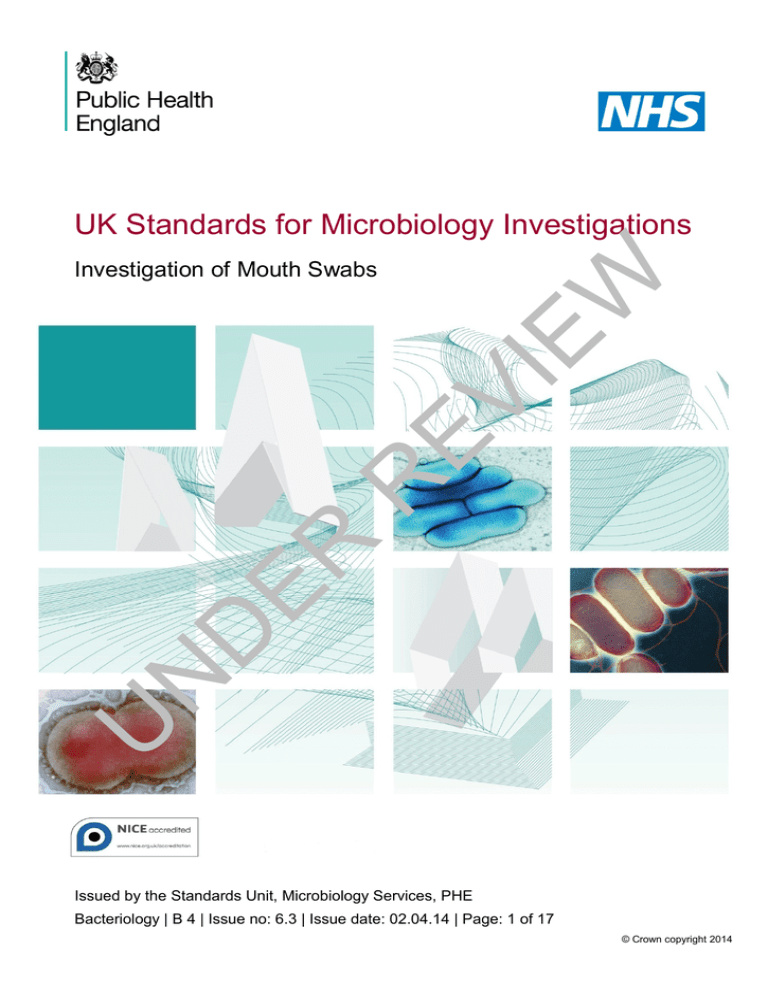
UK Standards for Microbiology Investigations U N D ER R EV IE W Investigation of Mouth Swabs Issued by the Standards Unit, Microbiology Services, PHE Bacteriology | B 4 | Issue no: 6.3 | Issue date: 02.04.14 | Page: 1 of 17 © Crown copyright 2014 Investigation of Mouth Swabs Acknowledgments UK Standards for Microbiology Investigations (SMIs) are developed under the auspices of Public Health England (PHE) working in partnership with the National Health Service (NHS), Public Health Wales and with the professional organisations whose logos are displayed below and listed on the website http://www.hpa.org.uk/SMI/Partnerships. SMIs are developed, reviewed and revised by various working groups which are overseen by a steering committee (see http://www.hpa.org.uk/SMI/WorkingGroups). Standards Unit Microbiology Services Public Health England 61 Colindale Avenue London NW9 5EQ E-mail: standards@phe.gov.uk Website: http://www.hpa.org.uk/SMI EV IE For further information please contact us at: W The contributions of many individuals in clinical, specialist and reference laboratories who have provided information and comments during the development of this document are acknowledged. We are grateful to the Medical Editors for editing the medical content. U N D ER R UK Standards for Microbiology Investigations are produced in association with: Bacteriology | B 4 | Issue no: 6.3 | Issue date: 02.04.14 | Page: 2 of 17 UK Standards for Microbiology Investigations | Issued by the Standards Unit, Public Health England Investigation of Mouth Swabs Contents ACKNOWLEDGMENTS .......................................................................................................... 2 AMENDMENT TABLE ............................................................................................................. 4 UK SMI: SCOPE AND PURPOSE ........................................................................................... 6 SCOPE OF DOCUMENT ......................................................................................................... 8 SCOPE .................................................................................................................................... 8 W INTRODUCTION ..................................................................................................................... 8 TECHNICAL INFORMATION/LIMITATIONS ........................................................................... 9 SAFETY CONSIDERATIONS .................................................................................... 10 2 SPECIMEN COLLECTION ......................................................................................... 10 3 SPECIMEN TRANSPORT AND STORAGE ............................................................... 10 4 SPECIMEN PROCESSING ........................................................................................ 11 5 REPORTING PROCEDURE....................................................................................... 12 6 NOTIFICATION TO PHE OR EQUIVALENT IN THE DEVOLVED ADMINISTRATIONS .................................................................................................. 13 R EV IE 1 APPENDIX: INVESTIGATION OF MOUTH SWABS ............................................................. 14 U N D ER REFERENCES ...................................................................................................................... 15 Bacteriology | B 4 | Issue no: 6.3 | Issue date: 02.04.14 | Page: 3 of 17 UK Standards for Microbiology Investigations | Issued by the Standards Unit, Public Health England Investigation of Mouth Swabs Amendment Table Each SMI method has an individual record of amendments. The current amendments are listed on this page. The amendment history is available from standards@phe.gov.uk. 9/02.04.14 Issue no. discarded. 6.2 Insert Issue no. 6.3 Section(s) involved Amendment IE Amendment No/Date. W New or revised documents should be controlled within the laboratory in accordance with the local quality management system. Document has been transferred to a new template to reflect the Health Protection Agency’s transition to Public Health England. Whole document. EV Front page has been redesigned. Status page has been renamed as Scope and Purpose and updated as appropriate. R Professional body logos have been reviewed and updated. Standard safety and notification references have been reviewed and updated. ER Scientific content remains unchanged. 8/12.04.12 Issue no. discarded. 6.1 Insert Issue no. 6.2 Section(s) involved Amendment U N D Amendment No/Date. Whole document. Document presented in a new format. The term “CE marked leak proof container” replaces “sterile leak proof container” (where appropriate) and is referenced to specific text in the EU in vitro Diagnostic Medical Devices Directive (98/79/EC Annex 1 B 2.1) and to Directive itself EC1,2. Minor textual changes. Sections on specimen collection, transport, storage Reorganised. Previous numbering changed. Bacteriology | B 4 | Issue no: 6.3 | Issue date: 02.04.14 | Page: 4 of 17 UK Standards for Microbiology Investigations | Issued by the Standards Unit, Public Health England Investigation of Mouth Swabs and processing. Some references updated. U N D ER R EV IE W References. Bacteriology | B 4 | Issue no: 6.3 | Issue date: 02.04.14 | Page: 5 of 17 UK Standards for Microbiology Investigations | Issued by the Standards Unit, Public Health England Investigation of Mouth Swabs UK SMI#: Scope and Purpose Users of SMIs W Primarily, SMIs are intended as a general resource for practising professionals operating in the field of laboratory medicine and infection specialties in the UK. SMIs also provide clinicians with information about the available test repertoire and the standard of laboratory services they should expect for the investigation of infection in their patients, as well as providing information that aids the electronic ordering of appropriate tests. The documents also provide commissioners of healthcare services with the appropriateness and standard of microbiology investigations they should be seeking as part of the clinical and public health care package for their population. Background to SMIs EV IE SMIs comprise a collection of recommended algorithms and procedures covering all stages of the investigative process in microbiology from the pre-analytical (clinical syndrome) stage to the analytical (laboratory testing) and post analytical (result interpretation and reporting) stages. Syndromic algorithms are supported by more detailed documents containing advice on the investigation of specific diseases and infections. Guidance notes cover the clinical background, differential diagnosis, and appropriate investigation of particular clinical conditions. Quality guidance notes describe laboratory processes which underpin quality, for example assay validation. R Standardisation of the diagnostic process through the application of SMIs helps to assure the equivalence of investigation strategies in different laboratories across the UK and is essential for public health surveillance, research and development activities. ER Equal Partnership Working U N D SMIs are developed in equal partnership with PHE, NHS, Royal College of Pathologists and professional societies. The list of participating societies may be found at http://www.hpa.org.uk/SMI/Partnerships. Inclusion of a logo in an SMI indicates participation of the society in equal partnership and support for the objectives and process of preparing SMIs. Nominees of professional societies are members of the Steering Committee and Working Groups which develop SMIs. The views of nominees cannot be rigorously representative of the members of their nominating organisations nor the corporate views of their organisations. Nominees act as a conduit for two way reporting and dialogue. Representative views are sought through the consultation process. SMIs are developed, reviewed and updated through a wide consultation process. Quality Assurance NICE has accredited the process used by the SMI Working Groups to produce SMIs. The accreditation is applicable to all guidance produced since October 2009. The process for the development of SMIs is certified to ISO 9001:2008. SMIs represent a good standard of practice to which all clinical and public health microbiology laboratories in the UK are expected to work. SMIs are NICE accredited and represent # Microbiology is used as a generic term to include the two GMC-recognised specialties of Medical Microbiology (which includes Bacteriology, Mycology and Parasitology) and Medical Virology. Bacteriology | B 4 | Issue no: 6.3 | Issue date: 02.04.14 | Page: 6 of 17 UK Standards for Microbiology Investigations | Issued by the Standards Unit, Public Health England Investigation of Mouth Swabs neither minimum standards of practice nor the highest level of complex laboratory investigation possible. In using SMIs, laboratories should take account of local requirements and undertake additional investigations where appropriate. SMIs help laboratories to meet accreditation requirements by promoting high quality practices which are auditable. SMIs also provide a reference point for method development. The performance of SMIs depends on competent staff and appropriate quality reagents and equipment. Laboratories should ensure that all commercial and in-house tests have been validated and shown to be fit for purpose. Laboratories should participate in external quality assessment schemes and undertake relevant internal quality control procedures. W Patient and Public Involvement EV Information Governance and Equality IE The SMI Working Groups are committed to patient and public involvement in the development of SMIs. By involving the public, health professionals, scientists and voluntary organisations the resulting SMI will be robust and meet the needs of the user. An opportunity is given to members of the public to contribute to consultations through our open access website. R PHE is a Caldicott compliant organisation. It seeks to take every possible precaution to prevent unauthorised disclosure of patient details and to ensure that patient-related records are kept under secure conditions. The development of SMIs are subject to PHE Equality objectives http://www.hpa.org.uk/webc/HPAwebFile/HPAweb_C/1317133470313. ER The SMI Working Groups are committed to achieving the equality objectives by effective consultation with members of the public, partners, stakeholders and specialist interest groups. Legal Statement D Whilst every care has been taken in the preparation of SMIs, PHE and any supporting organisation, shall, to the greatest extent possible under any applicable law, exclude liability for all losses, costs, claims, damages or expenses arising out of or connected with the use of an SMI or any information contained therein. If alterations are made to an SMI, it must be made clear where and by whom such changes have been made. U N The evidence base and microbial taxonomy for the SMI is as complete as possible at the time of issue. Any omissions and new material will be considered at the next review. These standards can only be superseded by revisions of the standard, legislative action, or by NICE accredited guidance. SMIs are Crown copyright which should be acknowledged where appropriate. Suggested Citation for this Document Public Health England. (2014). Investigation of Mouth Swabs. UK Standards for Microbiology Investigations. B 4 Issue 6.3. http://www.hpa.org.uk/SMI/pdf Bacteriology | B 4 | Issue no: 6.3 | Issue date: 02.04.14 | Page: 7 of 17 UK Standards for Microbiology Investigations | Issued by the Standards Unit, Public Health England Investigation of Mouth Swabs Scope of Document Type of Specimen Mouth swab Scope This SMI describes the processing and bacteriological investigation of mouth swabs. This SMI should be used in conjunction with other SMIs. W Introduction Candidosis EV IE Candidosis is the most frequent type of oral infection. Infection of the buccal mucosa, tongue or oropharynx is usually due to Candida albicans. Species of yeast other than C. albicans, such as Candida krusei and Candida glabrata, can also occasionally colonise the mouth but are rarely associated with infection. However, they are becoming increasingly important, particularly in patients who are immunocompromised3,4. Cancrum oris (Noma or Gangrenous Stomatitis) ER R Cancrum oris (noma or gangrenous stomatitis) is a necrotising polymicrobic infection, rarely seen in the UK, arising in the severely debilitated and malnourished, with children most often affected particularly in Africa5,6. It is usually preceded by ulcerative (Vincent’s) gingivitis7. Vincent's gingivitis is diagnosed by microscopy, and the appearance of a fusospirochaetal complex is pathognomonic for the disease8. Sialadenitis Sialadenitis, or infections of the salivary glands (parotid, submandibular, sublingual and accessory parotid), include suppurative, chronic bacterial and viral parotitis5. D Parotitis U N Parotitis may result in pus exuding from the parotid glands, which is sampled via the mouth5. The predominant organisms causing suppurative parotitis are staphylococci, but members of the enterobacteriaceae and other Gram negative bacilli, viridans streptococci and anaerobes have been isolated. Chronic bacterial parotitis is due to staphylococci, or mixed oral aerobes and anaerobes. Mumps, influenza and enteroviruses are the usual viral agents of parotitis. Other infective causes of oral ulceration include syphilis, herpes simplex virus and Mycobacterium species. Fungi may attack the sinuses and encroach on the palate, eg Aspergillus species. Infection with Histoplasma can lead to ulceration of oral mucosa9. Specimens which may be submitted for the investigation of dental abscesses include pus (refer to B 14 - Investigation of Abscesses and Deep-Seated Wound Infections). Bacteriology | B 4 | Issue no: 6.3 | Issue date: 02.04.14 | Page: 8 of 17 UK Standards for Microbiology Investigations | Issued by the Standards Unit, Public Health England Investigation of Mouth Swabs Technical Information/Limitations Limitations of UK SMIs The recommendations made in UK SMIs are based on evidence (eg sensitivity and specificity) where available, expert opinion and pragmatism, with consideration also being given to available resources. Laboratories should take account of local requirements and undertake additional investigations where appropriate. Prior to use, laboratories should ensure that all commercial and in-house tests have been validated and are fit for purpose. W Specimen Containers1,2 U N D ER R EV IE SMIs use the term, “CE marked leak proof container,” to describe containers bearing the CE marking used for the collection and transport of clinical specimens. The requirements for specimen containers are given in the EU in vitro Diagnostic Medical Devices Directive (98/79/EC Annex 1 B 2.1) which states: “The design must allow easy handling and, where necessary, reduce as far as possible contamination of, and leakage from, the device during use and, in the case of specimen receptacles, the risk of contamination of the specimen. The manufacturing processes must be appropriate for these purposes.” Bacteriology | B 4 | Issue no: 6.3 | Issue date: 02.04.14 | Page: 9 of 17 UK Standards for Microbiology Investigations | Issued by the Standards Unit, Public Health England Investigation of Mouth Swabs 1 Safety Considerations1,2,10-24 1.1 Specimen Collection, Transport and Storage1,2,10-13 Use aseptic technique. Collect swabs into appropriate transport medium and transport in sealed plastic bags. Compliance with postal and transport regulations is essential. 1.2 Specimen Processing1,2,10-24 Containment Level 2. W Laboratory procedures that give rise to infectious aerosols must be conducted in a microbiological safety cabinet16. IE Refer to current guidance on the safe handling of all organisms documented in this SMI. The above guidance should be supplemented with local COSHH and risk assessments. Specimen Collection 2.1 Type of Specimens Mouth swab EV 2 R Sample pus if present, otherwise sample any lesions or inflamed areas. A tongue depressor or spatula may be helpful to aid vision and avoid contamination from other parts of the mouth. Optimal Time and Method of Collection25 ER 2.2 For safety considerations refer to Section 1.1. Collect specimens before antimicrobial therapy where possible25. Adequate Quantity and Appropriate Number of Specimens25 N 2.3 D Unless otherwise stated, swabs for bacterial and fungal culture should be placed in appropriate transport medium26-30. U Numbers and frequency of specimen collection are dependent on clinical condition of patient. 3 Specimen Transport and Storage1,2 3.1 Optimal Transport and Storage Conditions For safety considerations refer to Section 1.1. Specimens should be transported and processed as soon as possible25. If processing is delayed, refrigeration is preferable to storage at ambient temperature25. Bacteriology | B 4 | Issue no: 6.3 | Issue date: 02.04.14 | Page: 10 of 17 UK Standards for Microbiology Investigations | Issued by the Standards Unit, Public Health England Investigation of Mouth Swabs 4 Specimen Processing1,2 4.1 Test Selection N/A 4.2 Appearance N/A 4.3 Sample Preparation 4.4 W For safety considerations refer to Section 1.2. Microscopy (Refer to TP 39 – Staining Procedures). Stain for Vincent's organisms if clinically indicated. EV 4.4.2 Supplementary N/A Culture and Investigation 4.5.1 Pre-treatment N/A R 4.5 IE 4.4.1 Standard 4.5.2 Specimen processing ER Inoculate each agar plate with swab (refer to Q 5 - Inoculation of Culture Media for Bacteriology). For the isolation of individual colonies, spread inoculum with a sterile loop. Clinical details/ D 4.5.3 Culture media, conditions and organisms for all specimens: Specimen N conditions Mouth swabs Sabouraud agar Temp °C Atmos 35-37 air Time Cultures read Target organism(s) 40-48hr ≥40hr* Yeasts Fungi U Oral candidosis Incubation Standard media Fungal infection For this situation, add the following: Clinical details/ Incubation Specimen Supplementary media Mouth swabs Blood agar conditions Mouth ulcer Temp °C 35-37 Atmos Time 5-10% CO2 16-24hr Cultures read Target organism(s) ≥16hr Lancefield group A streptococcus Bacteriology | B 4 | Issue no: 6.3 | Issue date: 02.04.14 | Page: 11 of 17 UK Standards for Microbiology Investigations | Issued by the Standards Unit, Public Health England Investigation of Mouth Swabs S. aureus *Fungal culture may need to be prolonged if clinically indicated; in such cases plates should be read at ≥40hr and then left in the incubator/cabinet until required. 4.6 Identification Refer to individual SMIs for organism identification. Lancefield group A streptococcus Lancefield group level S. aureus species level Yeasts "yeasts" level 4.7 W 4.6.1 Minimum level in the laboratory Antimicrobial Susceptibility Testing Referral for Outbreak Investigations EV 4.8 IE Refer to British Society for Antimicrobial Chemotherapy (BSAC) and/or EUCAST guidelines. N/A 4.9 Referral to Reference Laboratories R For information on the tests offered, turnaround times, transport procedure and the other requirements of the reference laboratory click here for user manuals and request forms. ER Organisms with unusual or unexpected resistance, and whenever there is a laboratory or clinical problem, or anomaly that requires elucidation, should be sent to the appropriate reference laboratory. Contact appropriate devolved national reference laboratory for information on the tests available, turnaround times, transport procedure and any other requirements for sample submission: N D England and Wales http://www.hpa.org.uk/webw/HPAweb&Page&HPAwebAutoListName/Page/11583134 34370?p=1158313434370 Scotland U http://www.hps.scot.nhs.uk/reflab/index.aspx Northern Ireland http://www.publichealth.hscni.net/directorate-public-health/health-protection 5 Reporting Procedure 5.1 Microscopy Stain for Vincent's organisms: report on Vincent's organisms detected. 5.1.1 Microscopy reporting time Urgent microscopy results to be telephoned or sent electronically. Bacteriology | B 4 | Issue no: 6.3 | Issue date: 02.04.14 | Page: 12 of 17 UK Standards for Microbiology Investigations | Issued by the Standards Unit, Public Health England Investigation of Mouth Swabs Written report, 16–72hr for Vincent's organisms. 5.2 Culture Report clinically significant organisms isolated or Report other growth, eg: “Mixed upper respiratory tract flora,” or Report absence of growth. 5.2.1 Culture reporting time Clinically urgent culture results to be telephoned or sent electronically. 5.3 Antimicrobial Susceptibility Testing W Written report, 16–72hr stating, if appropriate, that a further report will be issued. IE Report susceptibilities as clinically indicated. Prudent use of antimicrobials according to local and national protocols is recommended. EV 6 Notification to PHE31,32 or Equivalent in the Devolved Administrations33-36 R The Health Protection (Notification) regulations 2010 require diagnostic laboratories to notify Public Health England (PHE) when they identify the causative agents that are listed in Schedule 2 of the Regulations. Notifications must be provided in writing, on paper or electronically, within seven days. Urgent cases should be notified orally and as soon as possible, recommended within 24 hours. These should be followed up by written notification within seven days. ER For the purposes of the Notification Regulations, the recipient of laboratory notifications is the local PHE Health Protection Team. If a case has already been notified by a registered medical practitioner, the diagnostic laboratory is still required to notify the case if they identify any evidence of an infection caused by a notifiable causative agent. N D Notification under the Health Protection (Notification) Regulations 2010 does not replace voluntary reporting to PHE. The vast majority of NHS laboratories voluntarily report a wide range of laboratory diagnoses of causative agents to PHE and many PHE Health protection Teams have agreements with local laboratories for urgent reporting of some infections. This should continue. U Note: The Health Protection Legislation Guidance (2010) includes reporting of Human Immunodeficiency Virus (HIV) & Sexually Transmitted Infections (STIs), Healthcare Associated Infections (HCAIs) and Creutzfeldt–Jakob disease (CJD) under ‘Notification Duties of Registered Medical Practitioners’: it is not noted under ‘Notification Duties of Diagnostic Laboratories’. http://www.hpa.org.uk/Topics/InfectiousDiseases/InfectionsAZ/HealthProtectionRegula tions/ Other arrangements exist in Scotland33,34, Wales35 and Northern Ireland36. Bacteriology | B 4 | Issue no: 6.3 | Issue date: 02.04.14 | Page: 13 of 17 UK Standards for Microbiology Investigations | Issued by the Standards Unit, Public Health England Investigation of Mouth Swabs Appendix: Investigation of Mouth Swabs W Prepare all specimens All specimens from Oral candidosis Fungal Infection Blood agar ER R Sabouraud agar EV IE All specimens from Mouth ulcer Incubate at 35-37°C 5-10% CO2 16-24hr Read ³ 16hr* U N D Incubate at 35-37°C Air 40-48hr Read ³ 40hr* Yeasts Fungi Lancefield group A streptococcus refer to ID 4 S.aureus refer to ID 7 *Fungal culture may need to be prolonged if clinically indicated; in such cases plates should be read at ³ 40hr and then left in the incubator/cabinet until required. Bacteriology | B 4 | Issue no: 6.3 | Issue date: 02.04.14 | Page: 14 of 17 UK Standards for Microbiology Investigations | Issued by the Standards Unit, Public Health England Investigation of Mouth Swabs References 1. European Parliament. UK Standards for Microbiology Investigations (SMIs) use the term "CE marked leak proof container" to describe containers bearing the CE marking used for the collection and transport of clinical specimens. The requirements for specimen containers are given in the EU in vitro Diagnostic Medical Devices Directive (98/79/EC Annex 1 B 2.1) which states: "The design must allow easy handling and, where necessary, reduce as far as possible contamination of, and leakage from, the device during use and, in the case of specimen receptacles, the risk of contamination of the specimen. The manufacturing processes must be appropriate for these purposes". W 2. Official Journal of the European Communities. Directive 98/79/EC of the European Parliament and of the Council of 27 October 1998 on in vitro diagnostic medical devices. 7-12-1998. p. 1-37. IE 3. Powderly WG. Mucosal candidiasis caused by non-albicans species of Candida in HIV- positive patients. AIDS 1992;6:604-5. 4. Forbes BA, Sahm DF, Weissfeld AS. Upper respiratory tract infections and other infections of the oral cavity and neck. In: Forbes BA, Sahm DF, Weissfeld AS, editors. Bailey and Scott's Diagnostic Microbiology. 11th ed. St.Louis, Missouri: Mosby; 2002. p. 899-906. EV 5. Chow AW. Infections of the oral cavity, neck and head. In: Mandell GL, Bennett JE, Dolin R, editors. Mandell, Douglas and Bennett's Principles and Practice of Infectious Diseases. 5th ed. Vol 1. Edinburgh: Churchill Livingstone; 2000. p. 689-702. R 6. Lehner T. The mouth and salivary glands. In: Ledingham JGG, Warrell DA, editors. Concise Oxford Textbook of Medicine.Vol 1. Oxford: Oxford University Press; 2000. p. 519-26. 7. Enwonwu CO, Falkler WA, Idigbe EO. Oro-facial gangrene (noma/cancrum oris): pathogenetic mechanisms. Crit Rev Oral Biol Med 2000;11:159-71. ER 8. Holbrook WP, Cawson RA. The problem of the taxonomy of the fusiform bacillus of acute necrotizing ulcerative gingivitis (Vincent's gingivitis). Antonie Van Leeuwenhoek 1990;57:55-8. 9. Gomes FO, Vieria FA, Sebastiao BA, Simao FM, Mota LA. Orofacial manifestations of histoplasmosis in HIV-positive patients: a case report. Medicina Oral 2001;6:101-5. D 10. Health and Safety Executive. Safe use of pneumatic air tube transport systems for pathology specimens. 9/99. N 11. Department for transport. Transport of Infectious Substances, 2011 Revision 5. 2011. 12. World Health Organization. Guidance on regulations for the Transport of Infectious Substances 2013-2014. 2012. U 13. Home Office. Anti-terrorism, Crime and Security Act. 2001 (as amended). 14. Advisory Committee on Dangerous Pathogens. The Approved List of Biological Agents. Health and Safety Executive. 2013. p. 1-32 15. Advisory Committee on Dangerous Pathogens. Infections at work: Controlling the risks. Her Majesty's Stationery Office. 2003. 16. Advisory Committee on Dangerous Pathogens. Biological agents: Managing the risks in laboratories and healthcare premises. Health and Safety Executive. 2005. Bacteriology | B 4 | Issue no: 6.3 | Issue date: 02.04.14 | Page: 15 of 17 UK Standards for Microbiology Investigations | Issued by the Standards Unit, Public Health England Investigation of Mouth Swabs 17. Advisory Committee on Dangerous Pathogens. Biological Agents: Managing the Risks in Laboratories and Healthcare Premises. Appendix 1.2 Transport of Infectious Substances Revision. Health and Safety Executive. 2008. 18. Centers for Disease Control and Prevention. Guidelines for Safe Work Practices in Human and Animal Medical Diagnostic Laboratories. MMWR Surveill Summ 2012;61:1-102. 19. Health and Safety Executive. Control of Substances Hazardous to Health Regulations. The Control of Substances Hazardous to Health Regulations 2002. 5th ed. HSE Books; 2002. 20. Health and Safety Executive. Five Steps to Risk Assessment: A Step by Step Guide to a Safer and Healthier Workplace. HSE Books. 2002. W 21. Health and Safety Executive. A Guide to Risk Assessment Requirements: Common Provisions in Health and Safety Law. HSE Books. 2002. IE 22. Health Services Advisory Committee. Safe Working and the Prevention of Infection in Clinical Laboratories and Similar Facilities. HSE Books. 2003. 23. British Standards Institution (BSI). BS EN12469 - Biotechnology - performance criteria for microbiological safety cabinets. 2000. EV 24. British Standards Institution (BSI). BS 5726:2005 - Microbiological safety cabinets. Information to be supplied by the purchaser and to the vendor and to the installer, and siting and use of cabinets. Recommendations and guidance. 24-3-2005. p. 1-14 R 25. Baron EJ, Miller JM, Weinstein MP, Richter SS, Gilligan PH, Thomson RB, Jr., et al. A Guide to Utilization of the Microbiology Laboratory for Diagnosis of Infectious Diseases: 2013 Recommendations by the Infectious Diseases Society of America (IDSA) and the American Society for Microbiology (ASM). Clin Infect Dis 2013;57:e22-e121. ER 26. Rishmawi N, Ghneim R, Kattan R, Ghneim R, Zoughbi M, Abu-Diab A, et al. Survival of fastidious and nonfastidious aerobic bacteria in three bacterial transport swab systems. J Clin Microbiol 2007;45:1278-83. 27. Barber S, Lawson PJ, Grove DI. Evaluation of bacteriological transport swabs. Pathology 1998;30:179-82. D 28. Van Horn KG, Audette CD, Sebeck D, Tucker KA. Comparison of the Copan ESwab system with two Amies agar swab transport systems for maintenance of microorganism viability. J Clin Microbiol 2008;46:1655-8. U N 29. Nys S, Vijgen S, Magerman K, Cartuyvels R. Comparison of Copan eSwab with the Copan Venturi Transystem for the quantitative survival of Escherichia coli, Streptococcus agalactiae and Candida albicans. Eur J Clin Microbiol Infect Dis 2010;29:453-6. 30. Tano E, Melhus A. Evaluation of three swab transport systems for the maintenance of clinically important bacteria in simulated mono- and polymicrobial samples. APMIS 2011;119:198-203. 31. Public Health England. Laboratory Reporting to Public Health England: A Guide for Diagnostic Laboratories. 2013. p. 1-37. 32. Department of Health. Health Protection Legislation (England) Guidance. 2010. p. 1-112. 33. Scottish Government. Public Health (Scotland) Act. 2008 (as amended). 34. Scottish Government. Public Health etc. (Scotland) Act 2008. Implementation of Part 2: Notifiable Diseases, Organisms and Health Risk States. 2009. Bacteriology | B 4 | Issue no: 6.3 | Issue date: 02.04.14 | Page: 16 of 17 UK Standards for Microbiology Investigations | Issued by the Standards Unit, Public Health England Investigation of Mouth Swabs 35. The Welsh Assembly Government. Health Protection Legislation (Wales) Guidance. 2010. U N D ER R EV IE W 36. Home Office. Public Health Act (Northern Ireland) 1967 Chapter 36. 1967 (as amended). Bacteriology | B 4 | Issue no: 6.3 | Issue date: 02.04.14 | Page: 17 of 17 UK Standards for Microbiology Investigations | Issued by the Standards Unit, Public Health England
